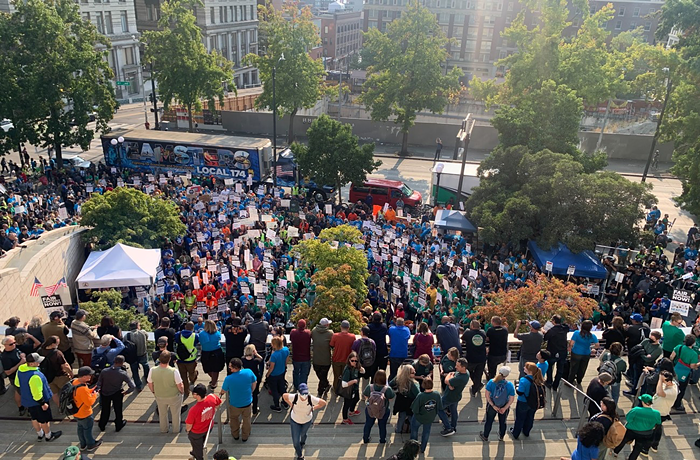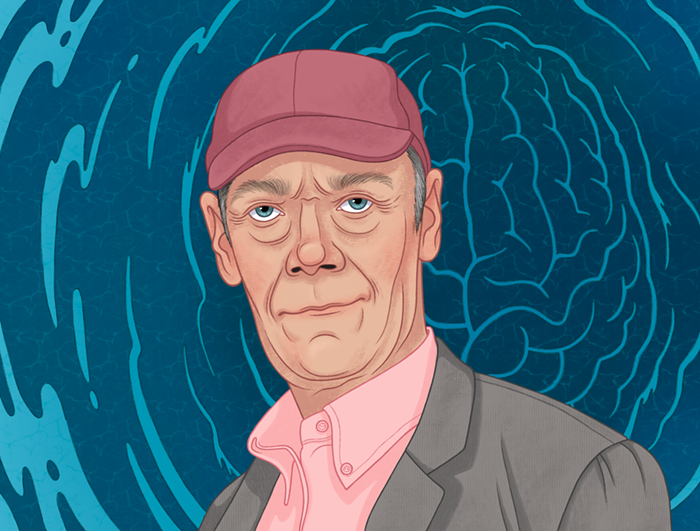
"Extreme" conditions, "open sewers", "significant public health, fire, safety, structural, and environmental risks." These were all things city officials wrote in a report released this week about the homeless encampment under I-5 known as "The Jungle." These are the types of things some media outlets are enthusiastic to cover.
But the report reveals something else, too: the risk of pushing people who do not immediately accept services farther and farther out of sight, as Mayor Ed Murray's administration continues to do.
After a shooting left two people dead and three others wounded in The Jungle last month, city staff lead by the fire department undertook a wide-ranging assessment of the area. Most of it is what you'd expect from a three-mile-long site with 200 tents and no access to sanitary services.
The presence of open sewers, human waste, and hazardous materials throughout the area under the interstate is a threat not only to the residents of the encampments but to state maintenance crews, people travelling on the interstate, and first responders. The accumulated human and solid waste from several hundred campsites presents a serious health concern and creates conditions ripe for the spread of disease.
There are fire hazards:
Because of the significant amount of frequent campfires for heat and cooking as well as the number of downed trees, dry brush, and debris accumulation, there are a large number of fires in the area. These pose a threat to the encampment residents, people in nearby neighborhoods, and to those who are travelling on the interstate.
In 2015, one encampment resident burned to death when he fell asleep with a small camp stove in his tent. As recently as February 2016, a tent on the periphery of the assessment area burned to the ground.
And environmental contamination:
Based on the visible conditions of the area, the assessment team estimates that in rain events, it is likely that waste, including contaminated dirty syringes, urine, feces, and hazardous materials, such as batteries, camping fuel, and chemicals, are entering the storm water system and being discharged into the Lower Duwamish Waterway.
And the potential for disease:
Because of the nearness of shelters to solid and human waste, rodent contamination is probable. The team noted signs of rodent activity, including burrows close to obvious shelters with sleeping arrangements in direct contact with the ground. Rats can spread disease if, for example, they come into contact with food that is later eaten by a human.
But there's also this (emphasis mine):
Many outreach workers and service providers report that they do not go into the freeway and greenbelt area for safety reasons. This means that some residents are disconnected from the access they need to more permanent housing solutions, treatment, employment assistance, and health care, among other needs.
This is what happens when people living outside are pushed out of the core of the city through policies like the city's ongoing sweeps of illegal tent encampments. In becoming more isolated from public view, they also become more isolated from service providers.
It's unclear whether anyone living in The Jungle right now ended up there as the result of being swept from somewhere else, but it is safe to say that when only 40 percent of people forced out of encampments accept shelter, the other 60 percent are going somewhere. It's likely some of them are going to more isolated locations like The Jungle. That only worsens their chances of ever accessing services.
At a press conference after the shooting in The Jungle, Mayor Ed Murray praised the outreach his administration does during encampment "cleanups," while acknowledging that outreach doesn't always get results on the first try. Murray gave an example: Outreach workers had encountered one woman sleeping outside three times and offered her access to shelter all three times. It wasn't until the fourth try that she accepted shelter.
Some people living outside are drug users. Some are alcoholics. Some have been assaulted in shelters. Some have anxiety and other conditions that make them unable to stay in large group settings. Some have pets. Some are couples, who currently can't find shelter space unless they separate. These are all factors that make it harder to take advantage of the options the city offers. That goes for both shelters and city-sanctioned tent encampments, where the city has imposed rules like a ban on alcohol and drugs, including marijuana. (It's worth remembering that alcohol and marijuana are legal for those of us fortunate enough to have a roof over our head.)
People's reasons for sleeping outside are complex. Connecting them to services takes time.
In a Seattle Times story this week, people living in vehicles explained why they don't plan move into the city's new "safe lots." (Emphasis mine.)
Cautiousness erupted into full-blown revolt this week, after social-service providers hired by the city came around the West Amory Way lot with a three-page document outlining rules for the new areas. No use of cooking stoves, propane heaters or power sources in the RVs, no unauthorized guests, no alcohol, drugs or smoking of any kind in vehicles. No exit or entry into the lots from 10 p.m. to 6 a.m.
“There’s a whole bunch of can’t, can’t and can’t,” said [Danny] Fletcher [a 32-year-old homeless Army veteran]. “There’s no freedom.” He added: “I should be able to do whatever I want in my home.”
This is not to say there isn't serious crime in The Jungle—the report says the area has "a high incidence of rape and sexual assault"—or that the city has no responsibility to clean up dangerous situations like this one. But if the city truly wants homeless people living outside to access services and sleep inside, policy makers must be realistic about what kinds of services people need. There must be options for people who are currently addicted, for people who are in relationships, and for people who have pets. Current barriers to shelter options mean a significant number of homeless people will continue to sleep outside. Pushing them out of sight will not change that fact.
One more thing: When NIMBYs argue that offering things like sanitation services will only enable or encourage homeless people to stay homeless, they ignore a simple fact: Homeless people do not go away because you deny them access to a dumpster or a portable toilet. Instead, they wind up in situations like The Jungle—situations the city says pose threats to the health of both the people living in the encampment and everyone living nearby.
If the city clears The Jungle but fails to offer realistic alternatives—low-barrier shelters and encampments—it won't be long before we're reading another report, just like this one, from some new version of The Jungle.


















